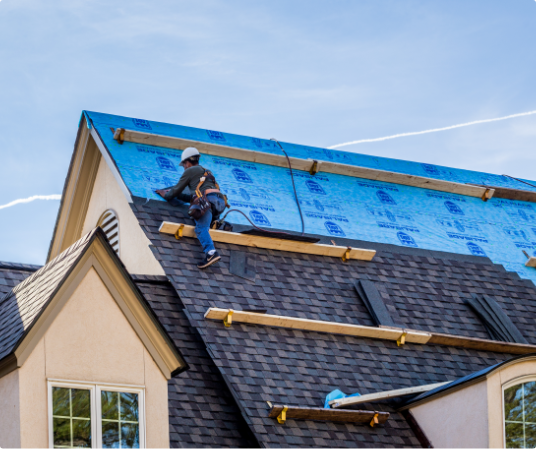Reviewing the Providers Offered by Roofing Companies in Gainesville Florida
Reviewing the Providers Offered by Roofing Companies in Gainesville Florida
Blog Article
Ideal Practices for Ensuring Proper Roof Covering Ventilation
A well balanced consumption and exhaust air vent ratio, typically 1:300, plays a critical role, with intake vents ideally placed at the lower edge of the roof for amazing air entry and exhaust vents at the peak for cozy air exit. Keeping insulation away from vents is crucial to avoid air flow restriction.
Understand Ventilation Fundamentals
Properly comprehending ventilation basics is vital for guaranteeing the longevity and performance of roof. Reliable air flow alleviates moisture accumulation and temperature extremes in the attic, both of which can lead to substantial structural damages with time. A well-ventilated roof helps in avoiding usual concerns such as mold and mildew growth, wood rot, and ice dams, which can endanger the integrity of the roof products and the underlying frameworks.
The primary objective of ventilation is to promote the motion of air, enabling a consistent exchange in between the outdoor and indoor settings. This equilibrium is achieved via a mix of intake and exhaust vents that interact to keep optimal airflow. Consumption vents, commonly situated along the eaves or soffits, allow fresh air to go into the attic space, while exhaust vents, typically located at or near the roofing ridge, make it possible for warm, humid air to leave.
Key factors affecting the efficiency of roofing air flow include proper positioning, adequate sizing, and making sure that both intake and exhaust vents are unhampered. Routine inspection and upkeep are important to recognize prospective obstructions, damage, or inefficiencies in the ventilation system, consequently securing the roof's performance and durability.
Types of Roof Covering Vents
Roofing system vents play a critical role in keeping efficient attic air flow and, by expansion, the total wellness of the roof covering system. Various sorts of roofing vents are available, each with one-of-a-kind advantages tailored to certain roof covering demands. Ridge vents, for example, are installed along the roof covering's top, permitting warm, humid air to escape from the attic. They use continual ventilation and blend flawlessly with the roofline, making them both reliable and aesthetically pleasing.

Soffit vents are installed under the eaves and operate in tandem with roof vents to guarantee a balanced consumption and exhaust system. By allowing cooler air to enter from below, soffit vents help with the expulsion of warm air through upper vents. Gable vents, situated on the exterior wall surfaces of the attic room, offer one more effective option, particularly in homes with saddleback roofs.
Evaluate Your Present Air Flow

Following, consider the age and condition of your roof covering materials and air flow parts. Older systems may not abide by present building regulations or may have worn away gradually, decreasing their effectiveness. Conduct an extensive evaluation to identify any type of indications of wear and tear, such as corrosion, damages, or voids that could endanger the system's performance.
Additionally, gauge the attic room temperature level and humidity levels. High temperatures and humidity can indicate insufficient air flow.
Installment Best Practices
Efficient setup of roof covering ventilation systems is critical for making certain ideal efficiency and durability. Appropriate installment starts with understanding the certain air flow requirements of the structure and the roofing it covers. This involves determining the right proportion of intake to exhaust vents, normally sticking to the 1:300 policy, which stipulates one square foot of ventilation for every 300 square feet of attic flooring room.

The positioning of vents is equally crucial. Consumption vents must be installed at the roofing's lower edge, often in the soffits, to enable cool air to get in. Exhaust vents, on the other hand, need to be installed near or at the roofing's height to help with the departure of cozy, damp air. This develops an all-natural airflow that assists maintain temperature level and wetness equilibrium within the attic room space.
Seal all air vent links thoroughly to protect against air leaks and potential water seepage. Usage top quality materials and follow maker guidelines to ensure resilience and effectiveness. Additionally, incorporating ridge vents with baffles can significantly improve air movement performance by avoiding wind-driven rain and snow from getting in the attic.
Ultimately, precise installation of roof covering air flow systems mitigates potential issues such as mold and mildew growth, ice published here dams, and architectural damages, making certain the roofing's honesty and the structure's total wellness.
Routine Upkeep Tips
Consistency in upkeep techniques is basic to ensuring the lasting efficiency of roofing air flow systems. Routine inspections are essential, ideally executed biannually-- in the springtime and fall. Throughout these examinations, make sure that vents are cost-free of particles, nests, and various other obstructions that could hamper airflow. Look for any kind of indicators of dampness build-up or mold, as these can indicate inappropriate ventilation or leaks (gainesville fl roofing companies).
Cleaning up the vents is another crucial job. Utilize a soft brush or a vacuum to eliminate dirt and particles from intake and exhaust vents. Be cautious not to harm the vent screens or louvers throughout the process. Furthermore, evaluate the attic room area for any indications of water damages, which might endanger the stability of the roof system.
Appropriate insulation is just as important. Make sure that attic room insulation does not block the vents, as this can badly restrict air movement. Rearrange or replace it to maintain an efficient obstacle. if any kind of insulation has actually shifted or worked out.
Last but not least, replace any type of harmed or missing out on components immediately. Damaged vents, fractured tiles, or deteriorated blinking can all contribute to inadequate ventilation and ought to be attended to without hold-up. Normal upkeep ensures that the roofing ventilation system functions ideally, thus expanding the lifespan of the roofing system itself.
Final Thought
Making sure appropriate roofing ventilation is critical for maintaining the performance and resilience of a roof. Adherence to the 1:300 consumption and exhaust vent ratio, coupled with the strategic placement of vents, is necessary. Normal biannual inspections, debris cleansing, and making sure insulation does not block air movement are essential methods. Implementing these best practices will certainly promote a well-ventilated roof, thus mitigating prospective issues connected to moisture accumulation and excessive warm, ultimately lengthening the roof's life expectancy.
A well balanced consumption and exhaust air vent ratio, frequently 1:300, plays a pivotal duty, with intake vents ideally positioned at the reduced side of the roof for amazing air access and exhaust vents at the optimal for cozy air exit. Intake vents, normally located along the eaves or soffits, permit fresh air to enter go to my blog the attic room, while exhaust vents, often located at or near the roofing ridge, make it possible for hot, moist air to run away.
Soffit vents are installed under the eaves and work in tandem with roof vents to ensure a balanced intake and exhaust system. By enabling cooler air to get in from below, soffit vents assist in the expulsion of warm air via top vents. Adherence to the 1:300 consumption and exhaust vent ratio, More about the author combined with the tactical positioning of vents, is essential.
Report this page